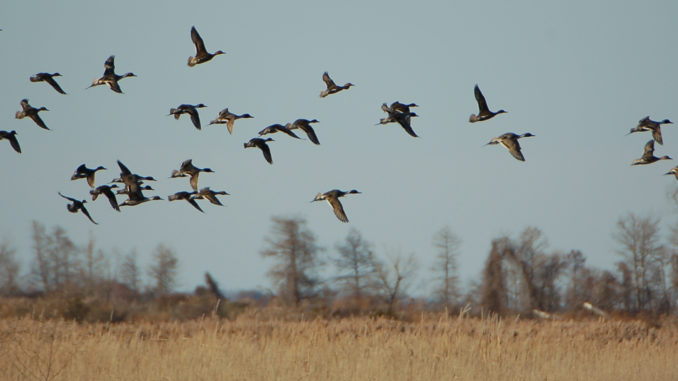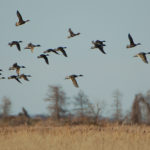
Majority of migrating birds haven’t arrived
The first few days of the Atlantic Flyway’s 60-day duck season have come and gone, with lower-than-expected success reported from hunters across the region. Even though a portion of the migrating flock crossed into the Carolinas in October, the majority of the early season harvest was resident birds as always, with a few green-wing and blue-wing teal taken in coastal areas. The major flocks are still yet to arrive, and there is still time for hunters to put the last few finishing touches on impoundments and duck holes before the first major migratory wave arrives.
In order to be prepared, hunters and land managers must understand the dynamics of migration. All waterfowl will migrate south at some point, but several factors affect how far they will move during each migratory travel event. Basically, two environmental factors — photoperiod and weather — evacuate migratory birds from their lush brooding grounds of Canada and the northern United States. As the days become shorter, migratory birds begin their journey south to escape the wrath of winter in the Canadian tundra. Ducks will begin to migrate as the days become shorter to avoid getting stuck in the arctic-like conditions.
Migrating flocks expend an exorbitant amount of energy and will seek out rich food sources along their route to fuel their travels. Foods full of carbohydrates and fat are preferred. Migratory routes for ducks along each flyway generally follow a path historically-known for rich foods within or adjacent to rivers, sounds, or swamps offering protection. Additionally, the colder it gets, the more food a duck must consume to survive. Food becomes a priority for migrating ducks.
But quite often, the migrating flock will not travel too far from their summer brooding grounds during mild weather. A rich food source under protection in the northern states will delay migration. This is where weather conditions become important. Blustery conditions and cold fronts must lock up their available food source in the north and send these birds south looking for greener pastures. While photo-periods initiates the migration progress, harsh weather must take over and flush these flocks into the swamps and flooded millet fields of the Carolinas.
Even though the first segment of duck season opens well before the major migrating flock arrives, the majority of the season is planned to allow time for significant weather to push migrating birds south. In many years, mild weather delays the full migratory flock until the last few weeks of the season. Last year, however, was one of the best seasons in recent history, thanks to an extended period of severe weather in November and December fast-tracked a significant portion of the flock into the Carolinas, leading to the extraordinary success from duck hunters across the region.
Early cold fronts can push birds down, and duck hunters must be prepared. Hunters with impoundments will invest countless hours treating weeds, correcting soil chemistry, maintaining dikes and water-control structures, planting crops and ensuring they reach their maximum yield to provide incoming ducks with an ideal place to call home for a few months.
By the first week of November, impoundments should be fully flooded, welcoming any migrants into the area. While weather can be unpredictable, a migratory flight can blow in overnight from harsh weather in the north or just from shortening days. All fields must be ready for their arrival.
While food is important for ducks along their migratory route, these food sources should be protected from disturbance as well. Access roads to impoundments should be locked, and access should be limited. As ducks arrive and begin to feed in the impoundments, hunters and other visitors should stay away before the hunting season arrives and limit access during the season. Duck impoundments should be hunted no more than two days per week. Additionally, hunters should hunt only a portion of the day in these areas and should evacuate to allow birds to come in and feed for the remainder of the day. Constant pressure from hunting or other disturbance will force ducks to find other places to feed.
With cooler weather settling in, all hunters should get ready. The ducks are coming and will arrive any day now.
Stock trout in ponds for winter fishing
Very few areas around the state offer year-around ideal conditions for rainbow and brown trout. The mountainous region in the western part of the state is the only real place where trout can survive, with cool and well-oxygenated water throughout the year. However, water temperatures across the entire state will reach an ideal range during the winter, offering pond owners with trout opportunities.
While brown and brook trout can be stocked, rainbows are preferred at lower elevations, even along the coast. Rainbows can tolerate water temperatures up to 55 to 65 degrees but will die within a few hours when they rise above 70 degrees. Fall is an ideal time to stock trout in ponds for a winter fishery. Most have adequate foods available throughthe winter for these fish to survive. They will feed on larvae and worms on the bottom, but commercial fish food can be used as well.
Ponds for stocking trout should have a deep-water component greater than 10 feet to provide a cool-water refuge during periods of warm weather and to prolong survival as spring arrives. While ponds in the coastal plain can be suitable for sustaining a winter trout fishery, ponds in the Piedmont and farther west should have better success in prolonging a trout fishery over the winter through late spring.
While ponds under ideal conditions can support anywhere from 300 to 500 fish per acre, fall stocking should not exceed 200 to 250 fish per acre. Stocked trout with an adequate food source can grow anywhere from 1¼ to 2½ times their size over the winter, depending on the size of the fingerling or size stocked. For example, a 6-inch fingerling could reach 12 to 15 inches, but a 10-inch fish may grow only to 13 to 14 inches over the winter. All stocked fish, including warmwater species, should be acclimated to the pond. Temperature shock is a common instant or delayed mortality for stocked fish, especially trout.
As the spring approaches and waters warm, the remaining trout loafing around the pond will not go to waste and turn into turtle food. Trout can provide largemouth bass and catfish an energy-packed food source just before spawning occurs when waters become too warm to sustain trout in warmer climates.
All pond owners should know that this fishery will be temporary but can provide benefits for landowners wishing to have a different type of angling experience in their pond without heading to a stream in the mountains.
Encourage no-till cover crops for fall planting
During the fall months, the harvesting season is in full force, with corn, soybeans, sorghum, peanuts and other summer crops maturing and heading their way to the market.
The agriculture belt in the Carolinas has multi-faceted benefits for a wide variety of wildlife species for several reasons. While deer are major consumers of excess grains left from harvests, birds and small mammals within commercial agriculture areas depend on these areas to survive.
These agriculture fields provide many species of wildlife with a fall and winter food source from spillage from normal harvesting equipment. Not only are these fields full of available grains, the remaining stalks, plant litter, and weedy growth is ideal cover for small mammals and game birds. Rabbits, quail, dove and other non-game/game species must have this litter available to safely feast on the spillage. Aerial and terrestrial predators love these agriculture fields, and these small wildlife species must have cover to avoid being detected while feeding.
Clean disking and drilling a winter cover crops is a common farming practice, but it isn’t great for small mammals and birds. Cover crops have great benefits for farmers, reducing weed growth and soil compaction, improving soil fertility and preventing erosion. Typically, most farmers in the south will utilize winter wheat, oats, triticale, barley, rye, and even annual clovers as cover crops. No-till farming increases water storage and organic matter within the soil for cover and regular annual crops.
While strip-disking is a good wildlife management practice — especially near wood lines — wholesale disking removes all available cover throughout the field for small wildlife. Property owners with an interest in small mammals and birds should plant cover crops using no-till farming or direct planting.







Be the first to comment